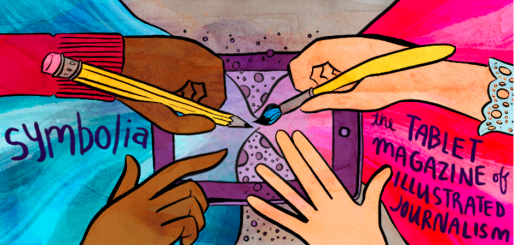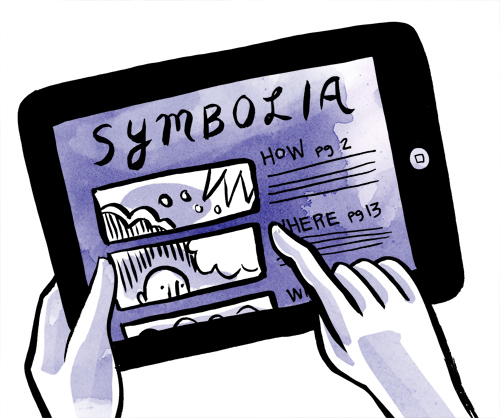Tablet technology has captivated the journalism world with its seemingly endless possibilities for expanding the form, yet most tablet-based publications are still cribbing from the traditional magazine format. Enter Symbolia, a visual cure for the common news story. In their own words:
Symbolia is a tablet magazine of illustrated journalism that pairs incendiary reporting with thoughtful illustration and comics. Our goal is to provide an immersive, engaging experience for a new generation of newshounds.
The brainchild of Erin Polgreen, Symbolia is poised to redefine how we understand journalism, particularly from a visual perspective. ONA caught up with Polgreen over email to get the scoop on Symbolia’s origin story.
How did you come up with the idea for Symbolia?
I got my first iPad last fall, and my first downloads were the ComiXology app and Once Magazine. I’d say the seeds for Symbolia were planted right after reading my first comic on the iPad. I’d long been a fan of reading comics on my iPhone, but tablets are a whole other ballgame. The difference in overall experience reminds me of David Lynch’s rant against watching movies on a cell phone. On tablets, illustrations and photographs look gorgeous, and adding sound and other sensory elements makes for an incredibly meditative and intimate space to enjoy a story.
It doesn’t hurt that I’ve been a huge comics fan since I was 15 — about the same time I started working at my local comics shop and freelancing for my local paper. Journalism and comics have always been two of my favorite things. Two years ago, I noticed a new crop of comics creators emerging, folks who were mixing beautiful art and smart journalism to a good degree of success. People like Susie Cagle, Matt Bors, Sarah Glidden and Wendy MacNaughton. I reached out to them and, with the help of a fellow comics nerd + journalist Sarah Jaffe, pulled a panel together at the National Conference for Media Reform in 2011 to talk about how comics were (and could!) change journalism. Things took off from there — I’ve spoken at SXSW, the Society for News Design, and given an ONAvation NewsU webinar, all focused on how news organizations can tell complicated stories using comics and illustration.
Something strange happens every time I talk about comics and journalism: Editors and designers are super psyched to work with comics because they get really great responses from audiences, but have a really hard time thinking about how exactly to create workflow processes that supported this work, or even how to find the talent.I think it’s a strange problem to have, and there are a lot of easy ways to incorporate this stuff. My presentation for Poynter included a five-step editorial workflow. I had built a great network of comics creators and journalists through my work covering the field and wanted to start practicing what I was preaching. Symbolia is my opportunity to really demonstrate how this stuff works, and to help the many talented creators I’ve met make money and build their own careers.
Why did you choose the tablet format? Will Symbolia still work with smart phones?
If there was a perfect space to experiment with new forms of storytelling, the tablet is as close as we’ve got right now. The tablet market is expanding dramatically, and news consumers on tablets tend to have higher incomes and also tend to be more engaged in the content. The iPad is dominating the market right now, but the Kindle Fire is catching up, and I’ve played with a few decent Android tablets.
Beyond the sexiness of these devices, the barrier for entry is incredibly low. There are some really great third-party tools emerging that make creating content for tablets a lot cheaper and easier, platforms like WoodWing, Graphic.ly, and Mag+.
My budget is considerably larger because I am firmly committed to paying contributors, but if you wanna go shoestring, you can.
We’re starting on the iPad, and I really want to be available on the Kindle Fire by the end of our first year. Phones are a bit of a difficult area, as it would require dramatically restructuring content from the tablet. Something that looks great on a tablet screen will not translate to a phone. We’re interested in making that leap, but probably not for a while as it would take considerable resources to reformat content. For me, it’s more important to create a way to buy and read issues on SymboliaMag.com than to break into phones.
How are you structuring the back end of Symbolia? What type of software/programming languages are you using? Who is doing the programming/design work?
Right now, we’re using Mag+, an interactive publishing tool with an InDesign plugin, to create Symbolia. The barrier for entry to creating interactive content for tablets is falling, and if you know a little HTML5 and are great with Adobe’s Creative Suite, chances are you can make something fun.
Symbolia’s wonderful Creative Director, Joyce Rice, has built some templates that incorporate spot animation, ambient audio, and really cool interactive layers and infographics. She and I will work together to storyboard content, plot out the visual look and feel of each issue, etc. I’m really excited to work with our contributors to create an interactive story that highlights their unique sensibilities.You don’t need to be a technologist to create an app anymore, which is really great. You just need to have a superb sense of design and be comfortable thinking about a story from the perspective of the user.
You won a grant from the McCormick Foundation to help launch Symbolia. What was the process like to write a grant for your idea? Did they let you submit it in comics form?
I’ve been awarded two grants so far to get Symbolia off the ground, one from J-Lab and the McCormick Foundation’s New Media Women Entrepreneurs program, the other from the International Women’s Media Foundation. I didn’t submit my grant applications in comics form, though I wish I had! Writing the grants was actually a lot like building a program strategy or sketching out a business model. I spent a few days plotting things out, then asked for feedback from my mentors before submitting. Both applications asked really smart questions about my networks, my working style, my understanding of the market, my business model, and my plans for making Symbolia sustainable. And speaking of sustainability …
What’s your plan for making Symbolia sustainable?
Ultimately, I want half of Symbolia’s revenue to come from subscriptions. The other half will be a mixture of ads and co-sponsored content. Because Symbolia will be relatively siloed in the tablet market, it will be critical for me to get the word out creatively. I’m reaching out to news organizations to talk about splitting the editorial production costs for content in exchange for syndications rights on the web, so long as Symbolia gets credit. I’m also really excited about the future of tablet advertising. Symbolia will be the ideal place for book publishers to advertise content from the exploding non-fiction graphic marketplace. Graphic novels and non-fiction narratives are booming, and I want to capitalize on that.
Unlike publishing something straight to the web, there’s a subscription-based business model that can actually support tablet content. Symbolia will start to break even somewhere between 1,700 and 2,000 subscribers. At 2,500 subscribers, we start turning a (small) profit. Those numbers are very achievable, especially considering that there really isn’t anything else like Symbolia out there yet.
Thanks to these grants, I have a year to reach this subscriber benchmark. I’ve got plenty of plans for making that happen, including a Kickstarter campaign geared towards driving subscriptions this fall.
How do you envision Symbolia working as a two-way conversation?
Driving conversation and interaction with users is a tricky thing. Working on a tablet publication feels like a throwback in some ways. I was joking the other day about making a “letters from our community” page. It’s not super easy to engage users in a dialogue around content. You can make social sharing mostly seamless — the British Journal of Photography’s iPad publication does this extraordinarily well, as does the HTML5-based tablet magazine Blackline. But as to a forum for conversation, that’s a nut I’m still trying to crack.
I am thinking about it carefully, though. We build the first iteration of Symbolia’s website on Tumblr because that community is primed to share. As the first issue comes together, I plan on distributing sneak peeks of sketches and storyboards to help generate interest and build community.
See our ONAvations NewsU webinar featuring Erin offering practical tips for producing effective illustrated journalism: https://www.newsu.org/comics-illustrated-journalism




